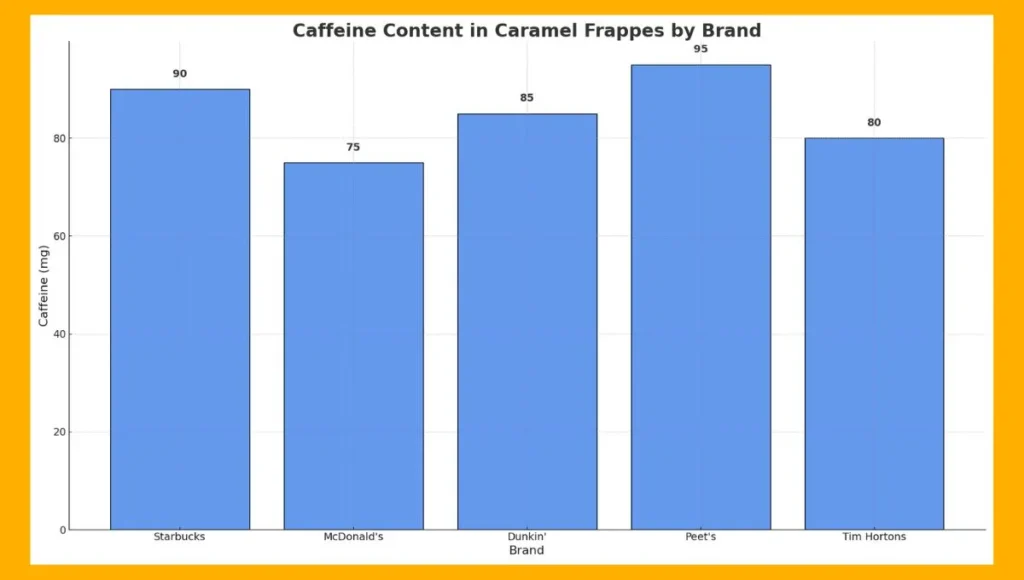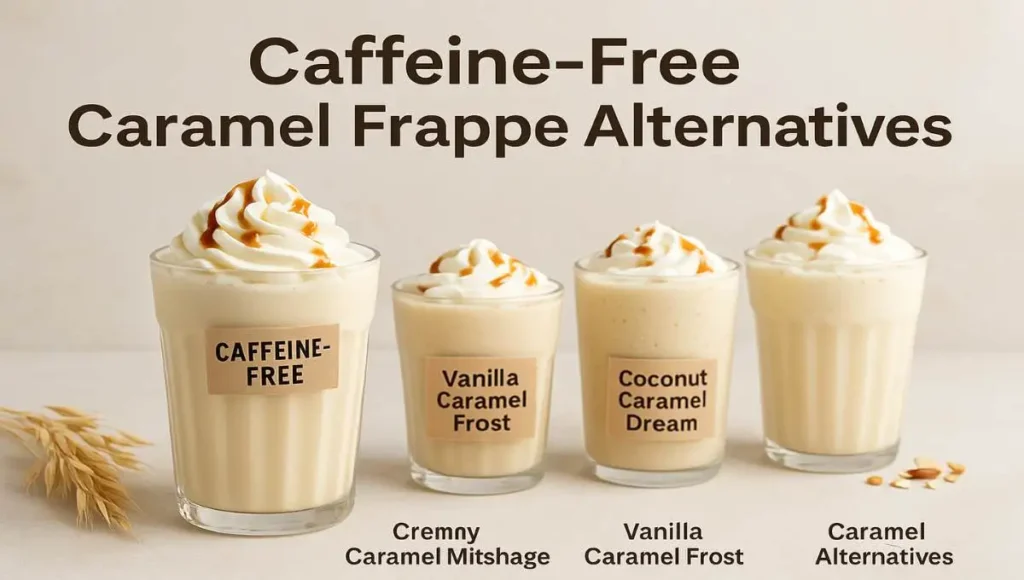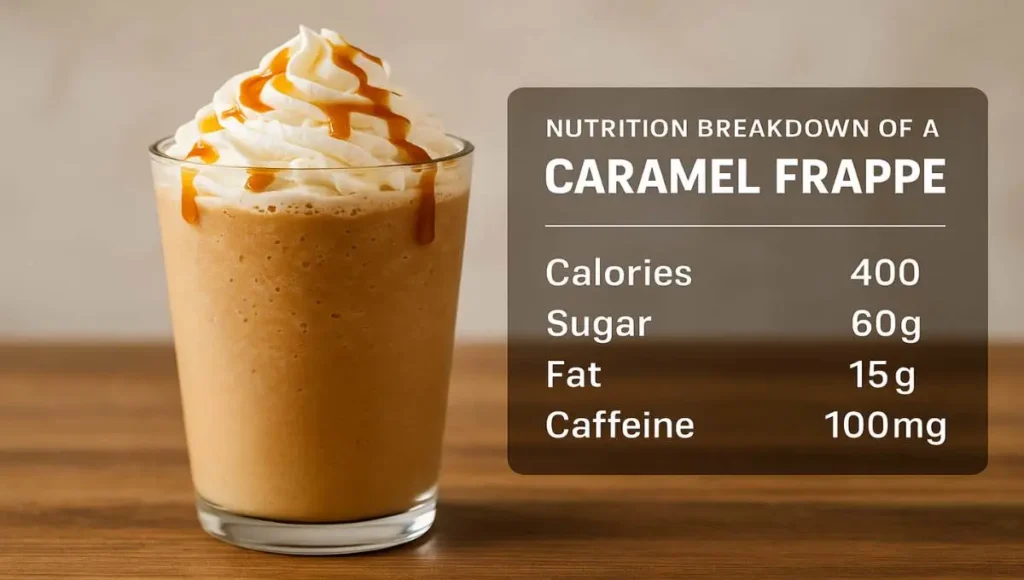The Caramel Frappuccino, a cold, creamy, sweet treat that debuted in 1999, quickly became an iconic, blended coffee drink enjoyed worldwide. I first tried it on a summer day, assuming it was just a dessert in a cup, but its energy boost caught me off guard.
With its caffeine, kick, and flavor cleverly hidden beneath whipped cream and caramel drizzle, this icy favorite raises an important question for the caffeine-sensitive and those watching intake. Is it a harmless indulgence or a real jolt in disguise?
In this guide, we’ll break down what’s actually inside—from Starbucks and McDonald’s to DIY options—to help you know, enjoy, or reserve it as an occasional, not daily, drink.
Quick Answer – Does a Caramel Frappe Have Caffeine?
Yes, caffeine is present in a caramel frappe, and it often surprises people who assume it’s just a sweet, chilled treat. The base of most frappes is coffee, often combined with espresso or shots that naturally boost the caffeine content. The total amount depends on several factors like size, customizations, or whether you’re ordering it at Starbucks or McDonald’s.
For example, a medium McDonald’s caramel frappe contains about 90 mg, while a grande from Starbucks has a similar content. You can check your brand’s nutritional info or simply ask if you’re curious or sensitive to caffeine.
From my experience working in cafés and writing about drinks for years, I’ve seen how easy it is for people to overlook what’s inside a frappuccino. Customizations like extra espresso or added syrup can increase the levels significantly.
While flavoring like chocolate, whipped cream, or other toppings don’t add much caffeine, they do contribute slightly to the overall mix. If you’re watching your intake, and trying to make informed decisions, knowing these little details really matters.
The drink may feel like a simple cream-topped dessert, but it can affect your energy. You might want to consume a smaller tall size or go decaf if needed. Either way, it’s always worth knowing how what you sip can add up.
✨ Create Your Dream Frappe ✨
Why You Should Care About Caffeine in Your Caramel Frappe
The Caramel Frappuccino is known for its sweetness, creamy texture, and strong coffee flavor, making it a global phenomenon loved by people of all ages. But from years of working in cafés and researching drinks, I’ve learned that truly understanding the caffeine content in your favorite drink is crucial—not just for obvious reasons, but for your health.
What might seem like a harmless dessert can give a surprising energy boost, which may lead to unwanted effects, especially if you’re sensitive to caffeine. Factors like size and additional shots of espresso can quickly alter the strength of what you’re sipping.
There’s a common misconception that it’s caffeine-free because of its blended nature and sweet flavor profile, but that’s far from true. If you’re someone keeping an eye on your caffeine consumption—whether due to a heart condition, pregnancy, anxiety, or trouble sleeping—knowing exactly what’s in your drink isn’t just helpful, it’s absolutely necessary.
Having the informed power to make better choices around your consumption is what turns a casual craving into a conscious one.
Caffeine Content in Caramel Frappes by Brand
If you’re wondering how much caffeine is in a caramel frappe, the answer depends on where you buy it. Here’s a breakdown of the most popular chains so you can choose the right option for your energy needs and preferences.

Starbucks Caramel Frappuccino
Sizes & Caffeine Content
Starbucks offers three main sizes, each with varying caffeine levels due to the amount of Frappuccino Roast (a blend of instant coffee):
- Tall (12 oz) – ~65 mg caffeine
- Grande (16 oz) – ~90 mg caffeine
- Venti (24 oz) – ~120 mg caffeine
These values may change slightly with added shots or other modifications.
Regular vs. Decaf Options
Starbucks lets you customize your caramel frappuccino with decaf espresso if you want to reduce or eliminate caffeine. However, the default Frappuccino Roast used in most versions contains caffeine and is not available in decaf form.
Pro Tip: To make a decaf caramel frappuccino, request “no Frapp Roast” and add decaf espresso shots instead.
Customizations (Make It Yours)
You can personalize your caramel frappuccino in many ways:
- Milk options: Types of milk you can choose from include whole milk, 2 percent, almond milk, soy milk, oat milk, and coconut milk.
- Shots: add espresso shots (regular or decaf) for more caffeine or flavor
- Toppings: You can customize your drink with additions like whipped cream, a mocha drizzle, or some extra caramel on top.
- Sweetness: adjust syrup pumps or use sugar-free alternatives
McDonald’s Caramel Frappe
Caffeine Content by Size
McDonald’s Caramel Frappes are made using a coffee-based blend that naturally includes caffeine. Here’s the typical caffeine breakdown by size:
- Small (12 oz) – ~75 mg caffeine
- Medium (16 oz) – ~90 mg caffeine
- Large (22 oz) – ~130 mg caffeine
Caffeine levels may vary slightly depending on location and preparation.
A Drive-Thru Favorite (But Watch the Sugar)
The McDonald’s Caramel Frappe is loved for its creamy texture and sweetness, making it a popular drive-thru treat. However, it contains more sugar and calories:
- A medium can contain over 60g of sugar and 450+ calories.
- Unlike Starbucks, McDonald’s does not offer a decaf or customizable caffeine option.
Summary Table: Caramel Frappe Caffeine Comparison
| Brand | Size (oz) | Caffeine (mg) | Customizable? |
| Starbucks | 16 (Grande) | ~90 mg | Yes (decaf, shots, milk) |
| McDonald’s | 16 (Medium) | ~90 mg | No |
| Dunkin’ | 16 (Medium) | ~90 mg | Yes (shots, swirls) |
What’s Inside a Caramel Frappe? (Ingredients & Additives)
- A caramel frappe is more than just a cold drink—it’s a thoughtfully made blend of ingredients designed for flavor and feel.
- The base typically includes coffee (which brings the caffeine), milk, sugar, and syrup, creating a smooth, creamy texture.
- Whether it’s a premade mix or a custom formula, it’s made to be refreshing, thick, and satisfying.
- Based on the brand or recipe, you may also get a subtle classic kick that blends perfectly with the sweet, decadent notes.
- Many fast-food chains and cafés use crushed ice to give it a slushy, icy chill.
- Optional espresso shots can be added for a stronger boost, or you might find concentrate used in some versions.
- There are also DIY, kid-friendly options that contain no coffee at all, making them caffeine-free.
- Flavor comes from syrup or buttery sauce, with many using custom flavorings to personalize the drink.
- For those with preferences or dietary needs, cafés offer whole, non-fat, oat, almond, or soy milk as alternative choices.
- A topping of whipped cream adds indulgence, finished off with a drizzle of caramel for sweetness and contrast.
- You can request light or sugar-free syrups to suit your taste without losing the richness.
- Behind the scenes, stabilizers and thickeners in the base help maintain the right texture, and every part—from the element to the topping—plays a role.
- Everything combines into a flavorful experience, where every dose matters, giving you a delicious pick-me-up or just a great-tasting treat.
Caffeine-Free Caramel Frappe Alternatives

If you love the flavor of a caramel frappe but want to avoid the caffeine, you’re not out of luck. There are several delicious options that capture the sweet, creamy experience — without the buzz. Whether you’re avoiding caffeine for health reasons, age, pregnancy, or simply preference, here are your best alternatives:
Starbucks Customization
You can absolutely get a decaf caramel frappe at Starbucks by customizing your order. The default version contains a caffeinated Frappuccino Roast, but you can request it without this and instead add decaf espresso shots.
This keeps the flavor profile largely intact while minimizing caffeine — ideal for those who want the experience of a frappuccino without the stimulant. The texture and sweetness stay the same, and it’s one of the best decaf-friendly options available at a major chain.
Homemade Options
Making a decaf caramel frappe at home is not only easy but also completely customizable. Use decaf instant coffee or a caffeine-free alternative like roasted chicory, and blend it with ice, your preferred milk or milk substitute, and caramel syrup.
The result is a creamy, cold, caffeine-free treat that’s perfect for any time of day. Top it with whipped cream and caramel drizzle to get that authentic coffeehouse feel — without the buzz.
Similar Non-Caffeinated Frappes
Vanilla Bean Crème
The Vanilla Bean Crème Frappuccino is one of the most popular non-caffeinated options at Starbucks. It has no coffee or tea base, making it completely caffeine-free.
Its creamy, sweet vanilla flavor makes it taste more like a milkshake than a coffee drink, and it’s often enjoyed by kids and adults alike. To bring it closer to the caramel flavor, simply ask for a caramel drizzle on top or even blended in.
Strawberry Crème
If you’re looking for a caffeine-free option, the Strawberry Crème Frappuccino is a delicious pick.It blends strawberry puree with milk and ice, delivering a fruity, smooth, and entirely coffee-free experience. It’s refreshing and ideal for warmer months or for anyone seeking a light, colorful drink with dessert vibes but no stimulant.
Mango Pineapple
Mango and pineapple frappes or smoothies, available at some cafes or homemade, are naturally caffeine-free. They rely on real fruit and yogurt or juice bases and provide a tropical flavor experience. While they differ in taste from caramel frappes, they hit the same icy, indulgent spot — just in a more fruity way.
Coconut Crème
Vegan and plant-based coffee shops often serve coconut crème frappes as a crowd favorite. They’re typically made with coconut milk, ice, and sometimes vanilla or sweetener. Rich and satisfying, these frappes skip caffeine altogether but still feel decadent. They also pair well with caramel or chocolate syrups if you’re looking to layer in more flavor.
Low-Caffeine Choices (Not 100% Caffeine-Free)
Matcha Green Tea
Matcha green tea frappes typically offer a moderate caffeine boost, with about 60 mg in a 16-ounce cup. Made from powdered green tea leaves, matcha provides a calmer, longer-lasting energy boost compared to coffee.
This drink includes L-theanine, an amino acid known to help reduce the nervous energy sometimes caused by caffeine. While it’s not caramel-flavored, it offers a creamy, subtly sweet alternative that can be made more dessert-like with add-ins like vanilla or white chocolate.
Iced Chai Latte
The iced chai latte is another low-caffeine option worth considering. It typically contains 40 to 50 mg of caffeine, thanks to the black tea base. Blending the warm spices of cinnamon, cardamom, and ginger gives the drink a cozy and richly spiced flavor profile.
It’s lower in caffeine than coffee or espresso drinks, yet still delivers a noticeable but manageable boost — especially when enjoyed iced on a warm day.
Nutrition Breakdown of a Caramel Frappe
When you grab a small Caramel Frappe, you’re not just getting a burst of flavor—you’re also getting a mix of nutrients and energy. It contains around 420 calories, with 75 milligrams of caffeine that offers a moderate energy boost.
You’ll get 7 grams of protein, but also a high sugar load with 44 grams of added sugars, which makes up 89% of your recommended daily intake.
There are 60 grams of total carbohydrates, making it a dense drink. On the fat side, it includes 17 grams of fat, of which 11 grams are saturated (56% of your daily value) and 0.5 grams are trans fat.
It does offer a bit of nutrition, with calcium at 200 mg and potassium at 360mg, though it also carries 55 mg of cholesterol and 80 mg of sodium.

How Often Should You Drink a Caramel Frappe? (Health Tips)
Caramel frappes are undeniably delicious, but they’re also high in sugar, calories, and caffeine — which means they’re best enjoyed occasionally rather than daily.
Recommended Caffeine Intake Per Day
Most health experts, including the FDA, recommend that healthy adults keep their caffeine intake under 400 mg per day. A medium caramel frappe contains about 90 mg, which is similar to a small cup of brewed coffee.
While having one may not put you over the limit, it can add up quickly—especially if you’re also consuming other caffeinated drinks like sodas, teas, or energy beverages. From personal experience, I’ve seen many customers who were unaware that even one frappe could sneak in a good portion of their daily caffeine without them realizing.
The content of caffeine in a caramel frappe can vary depending on size and brand. A Tall Starbucks Frappuccino (12 fl oz) has approximately 60mg, which is 15% of your RDI. The Grande (16 oz) offers around 90mg (22.5%), and a Venti (24 oz) boosts that to 120mg (30%).
On the other hand, a McDonald’s frappe contains 75mg in a small, 85mg in a medium, and 130 mg in a large size, adding up to 18.75%, 21.25%, and 32.5% of the recommended intake, respectively.
Though all sizes fall below the recommended limit of 400mg, adults should stay mindful of overall consumption across the day, especially since other foods and drinks can contribute additional caffeine without you even realizing.
When to Enjoy It Safely (Morning vs. Evening)
Timing matters when it comes to caffeine. Drinking a caramel frappe in the morning or early afternoon is ideal, especially if you’re caffeine-sensitive. Having one too late in the day — such as after 4 p.m. — may affect your sleeping pattern. Since it’s also loaded with sugar, enjoying it alongside a meal can help reduce blood sugar spikes and crashes.
Tips to Balance Caffeine with Hydration and Diet
To maintain a healthy balance, limit caramel frappes to once or twice a week. They should be considered a treat, not a daily habit. Pair your frappe with high-protein or fiber-rich foods to help offset the sugar impact, and be sure to drink plenty of water throughout the day. If you’re craving the flavor but want less impact, try a smaller size or explore decaf or caffeine-free alternatives.
Final Thoughts
Yes, a Caramel Frappe does contain caffeine, and while the amount can vary depending on the size of the drink or whether extra shots of espresso are added, it’s something worth considering if you’re sensitive or simply monitoring your intake.
From my time working in cafes, I’ve found that many customers don’t realize how quickly caffeine can add up, especially when they also consume other caffeinated drinks throughout the day. If you’re looking to enjoy a frappe as an occasional treat, there are ways to make it work for your health goals—try a smaller portion, a decaf version, or even a caffeine-free Crème Frappuccino or fruity smoothie.
Moderation truly is key, and it’s perfectly fine to indulge now and then, but not something to rely on as a daily habit. You can always check your favorite brand’s nutritional chart for accurate information, or better yet, make a homemade one where you can control the ingredients and tailor it to suit your needs.
Whether you’re drawn to the delicious, indulgent flavor or just want a quick boost, being aware of what you’re sipping helps you make smarter choices that align with your long-term goals.
FAQs
Does a caramel frappe have more caffeine than regular coffee?
Not usually. A medium caramel frappe contains about 90 mg of caffeine, which is similar to an 8 oz cup of brewed coffee. However, regular coffee tends to have more caffeine per ounce, so if you’re looking for a strong energy boost, coffee is typically the more potent option.
Can I order a caffeine-free caramel frappe at Starbucks?
Yes, you can. Ask for no Frappuccino Roast and request decaf espresso shots instead. While the flavor will stay similar, the caffeine content will be drastically reduced, making it a great option for those trying to avoid stimulants.
Is a caramel frappe safe for kids or teens?
Caramel frappes contain both caffeine and high levels of sugar, which is why they’re not ideal for young children. For teens, an occasional small size is usually fine, but daily consumption should be avoided due to the sugar and stimulant content.
Which caramel frappe has more sugar — Starbucks or McDonald’s?
The McDonald’s Caramel Frappe typically has more sugar, with around 60 grams per medium compared to 54 grams in a Starbucks Grande. Both are high in sugar and best enjoyed occasionally as a treat rather than a daily habit.

